I remember sitting in my living room as a child and watching a quail hit our picture window. It made a HUGE noise and sadly he ended up dying from the impact. It was an incredibly sad thing to witness as a child.
If you love to watch birds in your yard but hate when they fly straight into your windows, I am going to share a few ways to keep most birds safe from harm. From making your windows highly visible to adding shiny objects nearby, keep reading for bird deterrents that really work.
Posts feature partner companies & may be sponsored. Post contains affiliate links & I will be compensated if you make a purchase after clicking on links. As an Amazon Associate I earn from qualifying purchases.
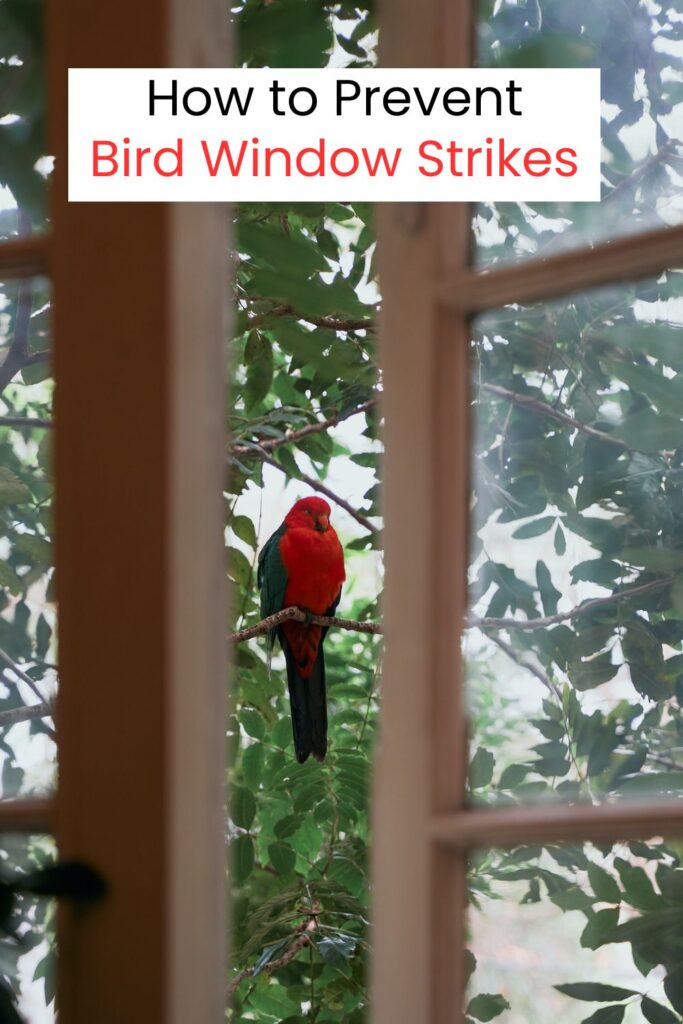
Table of Contents
Why do birds fly into windows?
Birds don’t know about glass. When they see reflections of trees, the sky, or other birds in a window, they think it’s an opportunity to join their friends or investigate a new area. This behavior is more common during the breeding season (typically in the spring and summer months). This is when birds are trying to establish territories and attract mates. It’s also seen when young birds are learning how to fly.
A peak into bird behavior
Backyard birds often fly into windows due to a combination of factors, primarily related to their perception of the environment. One major reason is that birds may perceive reflections on windows as a continuation of the surrounding landscape. This is particularly true when windows reflect trees, sky, or vegetation, creating an optical illusion that confuses them. Birds may also mistake transparent or clean windows for open spaces. Then they try to fly through them in search of a clear flight path.
Another factor that contributes to collisions is the presence of indoor lighting at night. Birds migrating during the night are often attracted to bright lights. This can disorient them and cause them to collide with windows. Artificial light can interfere with their natural navigation systems. Those lights can lead to confusion and a higher risk of collisions.
Additionally, birds may also fly into windows during territorial disputes during mating season. They may think their own reflection is an intruding bird. This can lead to aggressive behaviors that result in collisions.
The positioning of windows within a building can also increase the likelihood of collisions. Windows located close to bird feeders or near bird-attracting landscaping are more prone to collisions.
Similarly, windows positioned along migratory flyways or in areas with high bird populations are at a greater risk of collisions. To stop birds from flying into a glass window, it is crucial to understand these factors and implement preventative measures.
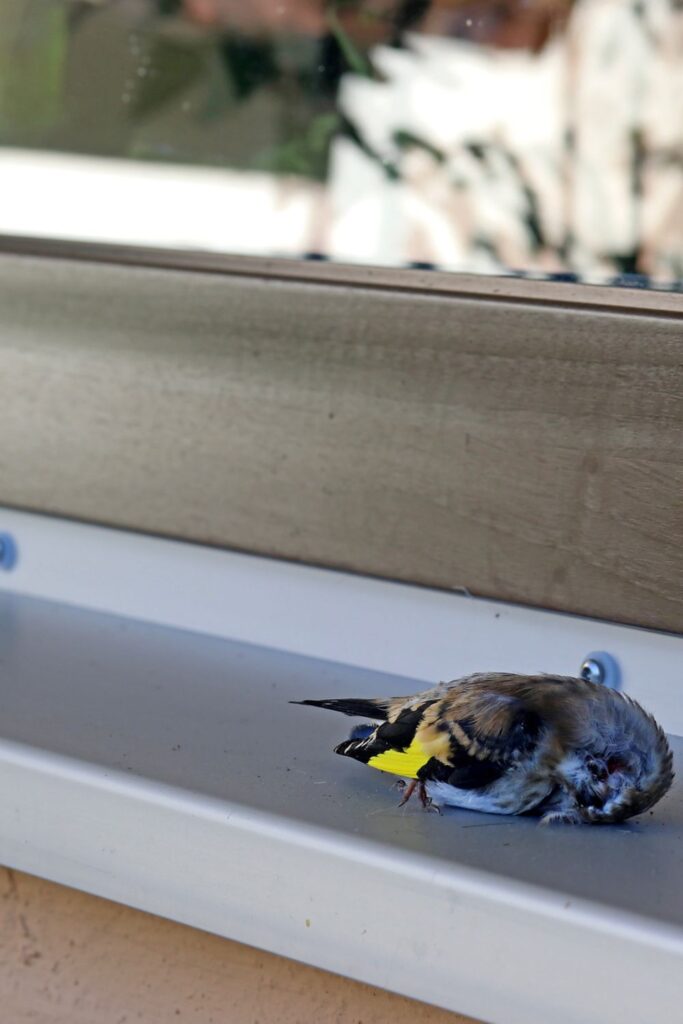
✯Don’t want to miss the next post?✯
Follow Turning the Clock Back on Facebook | Twitter | Pinterest
Or join the private Facebook group for simple tips on going green!
Birds crashing into windows is a BIG problem
So, why should you be so concerned about the safety of your feathered visitors? This is a significant problem with several far-reaching consequences.
Bird fatalities:
Collisions with windows cause millions of bird fatalities each year. The high-speed impact can result in fatal injuries, including broken necks, wings, or internal trauma. This loss of bird life has ecological implications. It disrupts ecosystems and potentially endangers species already facing conservation challenges.
Conservation concerns:
Many bird species are already in decline due to habitat loss, climate change, and other human-related factors. Window collisions make things worse by adding to the mortality rate. The loss of even a few birds can have negative effects on the overall health and stability of ecosystems.
Biodiversity impact:
Birds play a crucial role in ecosystems as seed dispersers, pollinators, and insect controllers. When they collide with windows, it disrupts these vital ecological functions. This may lead to potential imbalances in plant regeneration, pest control, and overall biodiversity.
Economic implications:
The economic impact extends beyond conservation concerns. For example, collisions with buildings often occur in urban areas with large glass structures. Cleaning up bird carcasses, repairing damaged windows, and dealing with the associated maintenance costs can be financially burdensome for property owners.
Human emotional toll:
Witnessing these collisions can be distressing for individuals who care about birds and wildlife. The sight of injured or dead birds can evoke feelings of sadness and helplessness, affecting people’s emotional well-being and connection to nature.
Implementing effective collision prevention measures not only protects bird populations but also promotes ecosystem health, preserves biodiversity, and contributes to a more harmonious coexistence between humans and wildlife.

How to deter birds from windows
If you have birds fly into your windows regularly, here are just a few options to consider:
Products that may help
I will explain a few of these later in the article, however, here are a few things you might want to buy to prevent bird strikes:
- Reflective Bird Tape: Put this on the outside surface of your window to catch the sun.
- WindowAlert UV Liquid Marker: Draw patterns on the glass that THEY can see but you won’t.
- UV reflective decals are an easy-to-use method to make the glass visible to our feathered friends.
Even just adding some verticle blinds will go a long way in preventing window collisions.
Install window decals or stickers designed to deter birds.
Installing window decals, bird tape, or stickers designed to deter birds is a relatively simple method to reduce collisions. These decals and stickers are specifically designed to make the glass more visible to birds. They come in various shapes, patterns, and sizes, offering both functional and decorative options.
One popular type of window decal is the patterned decal, which features visually distinct designs that break up the reflection and transparency of the glass. These decals can mimic the appearance of frosted or etched glass, creating a visible obstruction that birds can easily detect. The patterns can range from intricate geometric shapes to natural motifs, providing an aesthetically pleasing solution that enhances the overall appearance of the window.
Reflective decals are another effective choice. These decals utilize materials that reflect light, creating flashes or shimmering effects that catch the attention of birds. The reflections make the window more conspicuous, signaling to birds that it is not a viable path for flight. These decals often feature holographic or metallic surfaces that produce striking visual effects, enhancing their deterrent capabilities.
UV decals or markers are a specialized type of window treatment that takes advantage of birds’ ability to perceive ultraviolet light. While human eyes cannot detect these markings, birds can see them clearly. UV decals are often applied in a grid pattern on the window, effectively alerting birds to the presence of a solid surface. These decals are particularly useful for large windows where other methods may be less practical or visually obtrusive.
Create a physical barrier with bird netting
Creating a physical barrier is an effective approach to prevent birds from flying into windows. One option is to install bird netting or mesh on the entire surface of your window. This mesh acts as a protective barrier, creating a physical obstacle that birds cannot fly through.
It is important to ensure that the mesh is securely attached and tightly woven to prevent birds from getting tangled or trapped. This method is particularly useful for larger windows or areas where other deterrent options may not be practical.

Hang a wind chime in front of the window
Use wind chimes or other noise-making objects near windows to help prevent collisions. The gentle and melodic sounds produced by wind chimes can act as an auditory cue for birds. This draws their attention and encourages them to alter their flight paths.
In addition to wind chimes, other noise-making objects can be strategically placed near windows to serve a similar purpose. For example, hanging bells or small metal objects that clink together in the wind. The key is to choose objects that are light enough to move with even the slightest breeze.
Make the window more visible
Attaching strips of colored ribbon or streamers to the window frame is a clever and visually engaging method to stop birds from crashing into windows. The fluttering and swaying motion of the ribbons or streamers catches the attention of birds, creating movement that distinguishes the window from the static surroundings.
The use of colorful ribbons or streamers is particularly effective because birds have a heightened sensitivity to vibrant hues. Opting for bright and contrasting colors, such as red, orange, or yellow. This can make the window stand out in the avian visual spectrum.
Ribbons or streamers can be easily attached to the window frame using hooks, clips, or adhesive tape. They can be adjusted to different lengths and densities, depending on the window size and the desired visual effect. This method is cost-effective and can be customized to match the aesthetic preferences of the surrounding environment.
Decorative and Privacy Window Films
Applying decorative window films or tint reduces reflections and enhances the visibility of glass for birds. Window film can be thin and transparent or decorative and opaque. You can often find nature-inspired designs that are incredibly pretty. They reduce glare, minimize reflections, and alter the appearance of the glass without obstructing the view from the inside.
One type of window film commonly used to prevent bird collisions is a UV-reflective film. This film contains a special coating that reflects ultraviolet light, which is visible to birds but not to humans. The reflected ultraviolet light creates a noticeable contrast between the glass and the surrounding environment.
Another option is to use anti-reflective window film or tint. These films are designed to reduce the amount of light reflected off the glass, making the window more visible and less mirror-like to birds.
Window film or tint is a long-lasting solution that is relatively easy to install. Additionally, window film offers additional benefits such as UV protection, heat reduction, and privacy, which also enhances overall energy efficiency.

Add some plants
Positioning indoor plants near windows is a clever way to create a visual barrier that helps reduce the risk of collisions. The lush foliage of indoor plants serves as a natural obstruction that breaks up the reflective surface of the glass.
The varied shapes, textures, and colors of leaves and flowers create a visually complex and contrasting backdrop that catches the attention of birds.
Additionally, indoor potted plants provide a multitude of benefits beyond bird collision prevention. They contribute to improved air quality, adding oxygen and removing toxins from the indoor environment.
It is important to consider the type of plants selected for this purpose. Choose plants with dense foliage, preferably with large or wide leaves. These characteristics offer better coverage and create a more effective visual barrier.
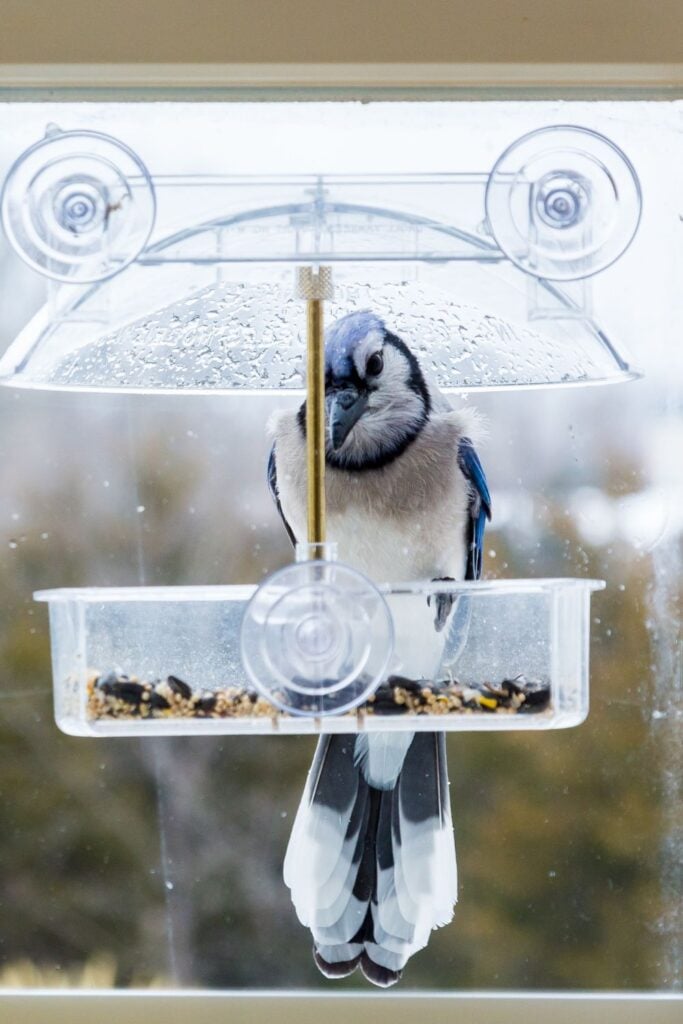
Attach a bird feeder to a problem window
Attaching a bird feeder to the exterior of a problem window can help create a safer environment for birds. By providing strategic access to food sources, individuals can encourage birds to land and rest before approaching the feeding area. This reduces the risk of collisions since birds are more likely to adjust their flight paths when they can easily access food without having to fly in circles or make sudden maneuvers.
Additionally, the presence of a bird feeder can create an effective visual deterrent against collisions. The bright colors and patterns of the feeder provide cues that birds will recognize as solid objects, helping them recognize the presence of the window and prevent potential collisions.
Attaching a bird feeder to a problem window also has the added benefit of providing individuals with an excellent opportunity to observe and interact with nature. This type of activity can be especially enjoyable for children. It helps them learn more about wildlife while providing them with an educational and engaging experience. A Smart Bird Feeder with Camera would be a great addition to your kitchen window.
Use soap
Apply soap or non-toxic window markers to the outside surface of your window to create temporary patterns or shapes on the glass. This method works by breaking up the reflection of the environment on the glass, making it less confusing for birds.
To create patterns or shapes on the window, use a squeegee to spread the soap over the glass in the desired design. The soap will be discreet but still visible enough for birds to recognize the presence of an obstacle.
Soap is also a temporary solution that can be easily and quickly removed when desired.

Close the blinds
Draw curtains or blinds partially closed to break up the reflective surface of windows. By adjusting the positioning of curtains or blinds, individuals can create a visual barrier that interrupts the clear view of the glass from the outside
When curtains or verticle blinds are partially closed, they introduce patterns, textures, and shadows that obscure the reflective qualities of the window. This change in appearance reduces the overall reflectivity and transparency, making it easier for birds to perceive the presence of a barrier.
This method provides a simple and adjustable solution that maintains the functionality and aesthetics of the window while promoting bird safety. It is important to strike a balance by finding the optimal degree of closure that minimizes reflections without compromising the desired amount of natural light and viewability.
- [Perfect solution to the falling problem]: I know very well that the suction cup acrylic window bird feeder does not have…
- [Super Sturdy Metal]: After research, we upgraded the acrylic material to a stronger and more Sturdy metal structure, without…
- [Easy to add and clean]: You can easily take the tray out to add bird food, the large capacity can hold 1.7 pounds of seeds;…
Feather-Friendly DIY Tape
Feather Friendly DIY Tape is an innovative solution to reduce the risk of collisions. This specially designed tape reflects ultraviolet light, which is visible to birds but not humans, in order to alert them that the window is a solid surface. The bright striping provides visual cues that help birds detect glass and other reflective surfaces from greater distances.
It is easy to apply and can be customized to fit any window size. The adhesive-backed tape is available in multiple colors, so you can choose a color that complements the look of your home. Additionally, this type of tape can be easily removed without leaving behind any residue or discoloration.
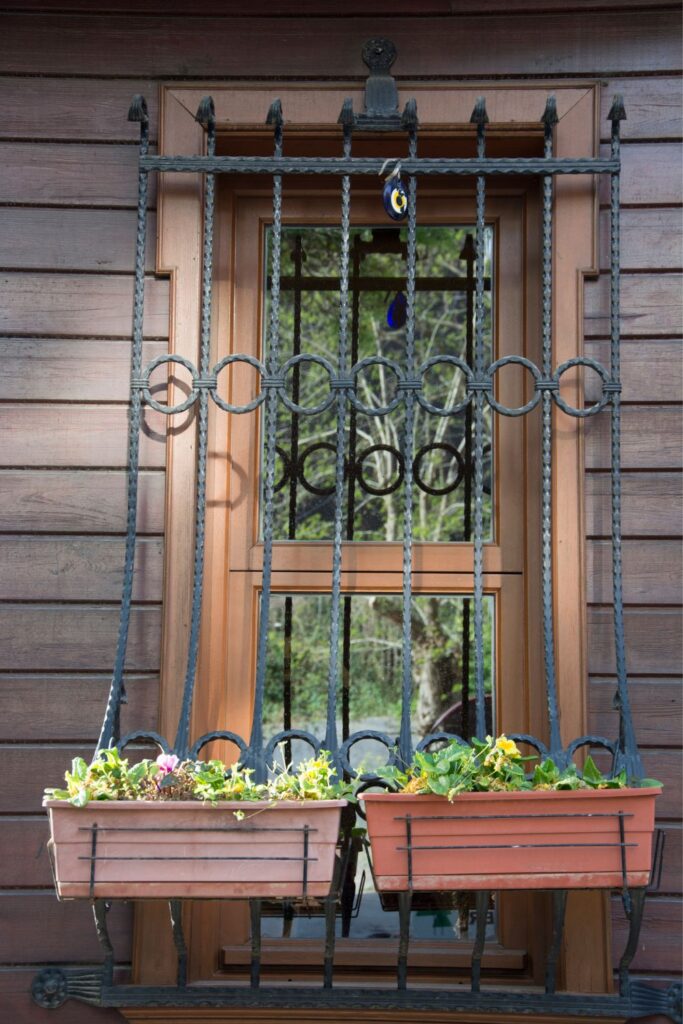
Window Grilles
Window grilles are a great way to protect windows from birds while still allowing for natural light and ventilation. They mount directly onto the window frame, creating an effective physical barrier that prevents birds from accessing the glass surface.
The grilles are available in a variety of designs, allowing individuals to choose a style that compliments their home decor. The grilles can be customized to fit different window sizes and shapes, making them suitable for virtually any type of window.
Install shutters
Exterior shutters are an effective solution for preventing birds from flying into windows. By installing shutters on the exterior of windows, you can adjust them to block the reflective surface of the glass. This eliminates or reduces the mirror-like effect that can confuse birds and deter them from attempting to fly through the window.
Overall, shutters provide a practical and versatile solution to stop birds from flying into windows. By creating a physical barrier and altering the reflective surface, shutters help birds recognize the presence of the window and avoid collisions.

Install window boxes
Hanging exterior window boxes filled with plants or flowers in front of windows creates a buffer zone that helps prevent bird collisions. These window boxes act as a physical barrier, creating a visual and physical obstacle between birds and the glass. By extending the window frame with lush vegetation, they encourage small birds to alter their flight paths and avoid colliding with the window.
The presence of window boxes filled with plants or flowers serves multiple purposes in bird collision prevention. First, the foliage creates a visual barrier that breaks up the reflection of the glass, making it more apparent to birds as a solid surface.
Secondly, the window boxes themselves introduce an additional level of complexity to the surroundings. The three-dimensional structure of the window boxes, combined with the foliage, adds depth and dimension, further enhancing the visibility of the window.
Here are five flowers that thrive in window boxes:
- Geraniums: Colorful and abundant bloomers, perfect for containers.
- Petunias: Offer a wide range of colors and cascade beautifully.
- Lobelia: Delicate, trailing flowers that thrive in cooler temperatures.
- Marigolds: Hardy, sun-loving flowers with pest-repellent properties.
- Nasturtiums: Versatile flowers with vibrant, edible blooms.
Make sure to consider lighting and container size when choosing flowers.
Install window film to help reduce glare
Using one-way transparent film on windows is an effective strategy for preventing birds from flying into them. The film disrupts the mirror-like quality of the glass, making it more visible and less confusing for birds.
It is important to follow the manufacturer’s instructions for proper installation and to choose high-quality films that are specifically designed for bird collision prevention, ensuring optimal effectiveness and longevity.
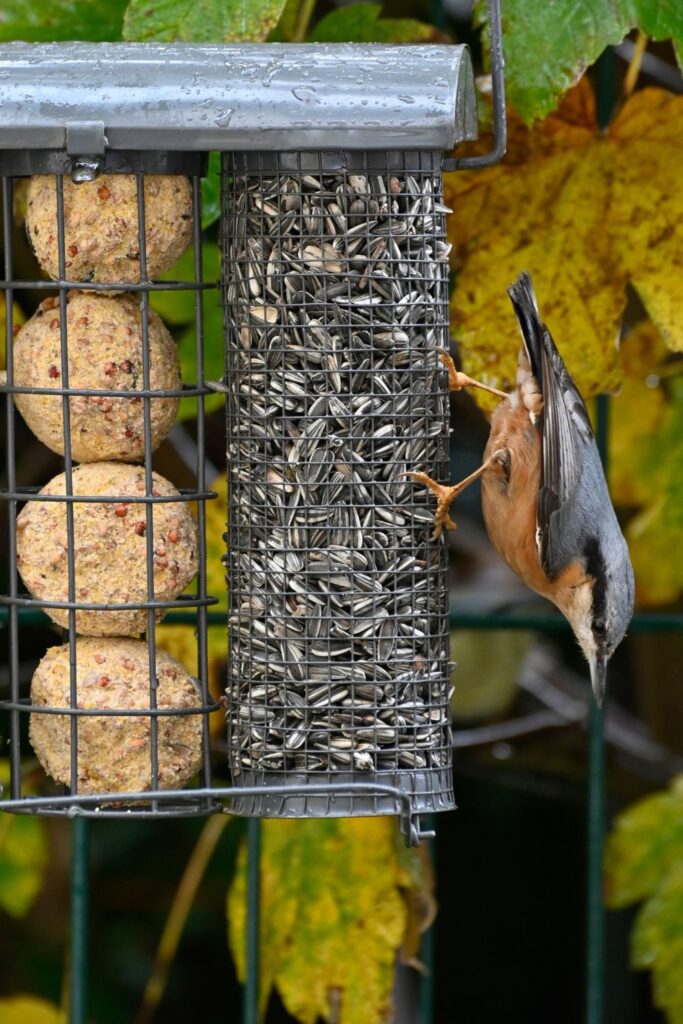
Don’t put your bird feeders in the “danger zone.”
Place bird feeders farther away from windows. By increasing the distance between the feeders and the windows, birds have a better chance of navigating safely and avoiding potential collisions.
One of the main reasons birds collide with windows is that they are often attracted to the reflection of vegetation or food sources. Placing feeders closer to windows can create a deceptive illusion, as birds may perceive the reflection as an extension of their feeding area. By moving the feeders farther away, the reflection becomes less prominent and less likely to confuse or entice birds toward the window.
Moreover, spreading the feeders throughout the yard or garden encourages a more natural foraging behavior, as birds have to explore and move between various feeding stations.
Providing alternative perching areas, such as shrubs or small trees, near the feeders can further encourage birds to land and rest before approaching the feeding area.
By placing your feeders farther away from windows, you can help create a safer environment for birds while still providing them with a valuable food source.
Replace existing windows with “bird-friendly” glass
If the risk of collisions is significant, it may be beneficial to replace existing windows with “bird-friendly” glass. This type of glass utilizes advanced technology that embeds a pattern or design either within the glass surface or between two layers of glass.
The pattern is designed to be visible to birds but almost invisible to humans, functioning as a visual cue that helps them recognize the presence of an obstacle and navigate around it. It is available in various designs, allowing individuals to customize their windows to suit specific needs and applications.
This type of glass also offers other benefits such as improved energy efficiency, sound insulation, safety, and security. Installing bird-friendly glass can help reduce heat loss in cold temperatures, as well as sound transmission in noisy environments.
Overall, installing a bird-friendly glass window is an effective way to stop birds from flying into windows. It provides a targeted visual signal that helps birds recognize the presence of an obstacle and navigate around it safely.

Keep the screens on your windows
Installing external screens or wire mesh on windows is a highly effective method for creating a physical barrier that prevents birds from flying into windows.
The primary function of external screens or wire mesh is to create a physical obstacle that birds cannot pass through. The fine mesh or netting acts as a barrier, preventing birds from accessing the window directly and reducing the risk of collisions. The mesh is designed with a small enough aperture to prevent birds from getting entangled while still providing visibility and airflow.
Installing external screens or wire mesh is a practical solution that provides long-term protection for windows. It can be customized to fit different window sizes and shapes and is durable and weather-resistant. The screens or mesh can be securely attached to the window frame, ensuring they remain in place.
Create movement
Attach hanging strips of colored beads or CDs near windows to create movement and deter birds. This method utilizes the reflective and moving properties of hanging objects to catch the attention of birds and discourage them from approaching windows. Check out my post on ways to reuse old CDs for some more creative uses for them.
By incorporating these visually stimulating elements, you can effectively break up the clear view of the glass and prevent birds from colliding with your windows.
When implementing this strategy, it is important to ensure that the hanging objects are positioned at an appropriate distance from the window to allow sufficient movement and visibility. The strips of beads or CDs can be securely attached to the window frame or suspended from a nearby structure using strings or hooks.
This approach harnesses the power of movement and reflective surfaces to break up the transparent appearance of windows and promote bird safety. It is an affordable, easy-to-implement solution that adds a touch of visual interest while effectively reducing the risk of yet another window collision.
Plant some shrubs
Plant tall shrubs or trees near windows to create a natural barrier and break up the reflection. By planting taller vegetation, individuals can break up the reflection of the sky and surroundings on the window. This serves as a visual deterrent that helps birds recognize the presence of an obstacle in their flight path.
In addition to reducing bird-window collisions, incorporating plants into the landscape also has other benefits such as adding beauty and interest to outdoor spaces. Plants also provide food and shelter for birds, which can help promote bird safety by discouraging them from approaching windows.
When selecting plants, it is important to look for species that are native to the local area. Native shrubs or trees will be better adapted to the local environment and offer greater benefits such as improved soil quality, increased resistance to pests and disease, and enhanced wildlife habitat.

Put up an awning
Install exterior window awnings or shades that reduce the amount of light reflecting off the entire window. By minimizing the amount of light that reflects off the window, individuals can reduce the visibility of the glass and discourage birds from approaching.
Awnings come in various shapes, sizes, and materials to suit different applications. When selecting an awning, it is important to consider the direction of the sun and ensure that it offers adequate protection. Additionally, individuals should opt for materials that are resistant to fading or discoloration from exposure to natural elements such as rain or sunlight.
Overall, exterior window awnings or shades offer an effective way to reduce light reflection off windows and discourage birds from approaching.

Use bird scare devices
Use bird scare devices such as fake predators, like owl or hawk decoys, near windows to scare away birds. The presence of a perceived predator in the area can cause birds to feel threatened and encourage them to alter their flight paths away from your windows. I have used them in my garden with mixed success.
When using this approach, select decoys that accurately mimic local predators as far as size, shape, and coloration are concerned. Hang the decoys in visible locations near windows and regularly reposition them to maintain their effectiveness. Additionally, use other methods such as sound deterrents or flicker lights to supplement the visual scare device for added protection against bird hits.
Redirect their attention
Create a bird-friendly habitat by providing water sources like bird baths, planting native vegetation, and avoiding the use of pesticides, which can attract birds to other areas of your property and away from windows.
Additionally, feeding birds away from your home can be a great way to redirect their attention and provide them with an alternative food source away from windows. Check out my post about how to grow sunflowers to get started.
By creating a bird-friendly habitat and providing alternate food sources, you can encourage birds to visit other areas of your property and stay away from windows. This provides birds with essential resources while reducing the risk of birds colliding with your glass windows. Additionally, providing water sources and avoiding the use of pesticides are great ways to promote a healthy bird population.

Stop the frequent window washing
Reduce the amount of window cleaning and avoid using glass cleaners that contain ammonia. Ammonia can create a reflection on the window and attract birds to your windows. Additionally, when washing windows, try to use an absorbent cloth instead of one with a glossy finish as this will reduce glare from the sun.

Conclusions and Further Reading
Anything that makes windows visible to birds will reduce the number of bird strikes that occur. From sun catchers to tempera paint, you have a lot of options. A kitchen window box full of herbs or a strategically placed potted plant can stop birds from colliding with your windows this spring.
If you want more bird-friendly tips, check out a few of these posts:
- Tips for adding wild bird nesting boxes to your yard.
- Winter bird feeding tips for happy and healthy backyard birds.
- How to attract birds to your yard.
I hope these tips have helped you protect your local bird population from glass windows. Now grab your binoculars and the next time a bird flies by you can breathe a sigh of relief that he is safe and sound! Check out my post on how to create a backyard oasis for more tips on a beautiful and peaceful backyard.

Diane is a professional blogger and nationally certified pharmacy technician at Good Pill Pharmacy. She earned her BS in Microbiology at the University of New Hampshire and has worked in cancer research, academics, and biotechnology. Concern over the growing incidence of human disease and the birth of her children led her to begin living a more natural life. She quickly realized that the information she was learning along the way could be beneficial to many others and started blogging and freelance writing to share this knowledge with others. Learn more about her HERE.

